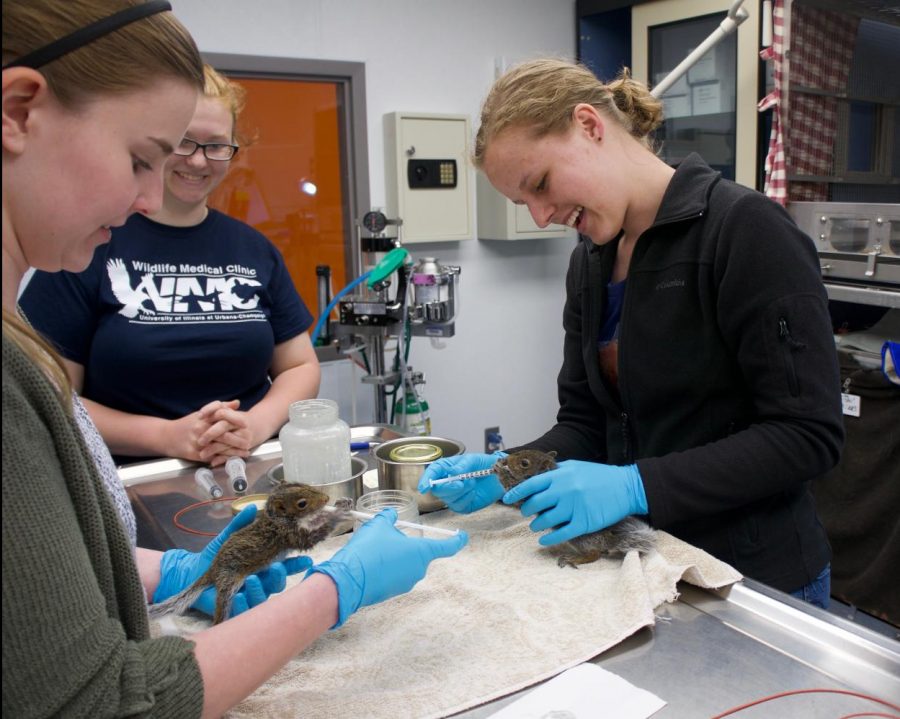Alexis Davidson, junior in ACES, was told never to become a veterinarian. Teachers warned her of the downsides.
According to The Boston Globe, the suicide rates of vets are four to six times that of the average person. Vet students spend the same amount on tuition as medical students, but go on to earn one third of what doctors or dentists will make. And after time, a vet’s mental health can start to suffer from compassion fatigue, which is the lessening of compassion over time that several physicians go through.
“I came into undergrad and everyone told me: ‘don’t do it,'” she said. Nevertheless, she persisted because she knew that this was her dream.
Now, Davidson is volunteering at the Wildlife Medical Clinic, where they take in wild animals that have become too wounded to care for themselves. Once the animals have been fully rehabilitated, they can be released back into the wild. The clinic takes every animal that they are legally allowed to accept: squirrels, raccoons, birds, bunnies, turtles, geese and plenty more.
She finds that working at the clinic has its good days and its bad days. Most days she feeds the animals, gives them their medication and changes their bandages. Some days she gets to care for an animal enough to get to release it back into the wild. Rarely, she gets an animal too sick or injured to be cared for, and it has to be humanely euthanized.
Get The Daily Illini in your inbox!
Either way, she doesn’t know what will await her when she comes into a shift.
Some of the most frustrating times are when people take in an orphaned animal instead of taking it to a veterinarian. “People will ‘save’ the animals and then keep them in their houses and they’ll get worse, and then they’ll bring them to us,” she said. “Unfortunately, if they’d brought it to us originally, we might have been able to save it.”
Luckily, most people contact the Wildlife Medical Clinic right away.
The clinic has just moved locations to allow more room for the animals they receive. The new location also comes with a room that will be used to educate visitors on wild animals.
Davidson said she works no more than 15 hours a week. The time commitment for the clinic depends of the time of year. During the winter, the clinic does not receive a lot of new animals because most have migrated or hibernated for the winter. But on rainy spring day where animals go through a quick weather change, the volunteers can expect up to five new patients being brought in.
During her last shift she received two cases: a nest of six new bunnies and then two new squirrels, making it hectic to check every single animal before the end of her shift.
Despite all of this, Davidson absolutely loves working for the clinic.
“You get those days where you work really hard and you have these animals that come in an you see them all the way through their treatment and you get to release them, that makes it worth it,” she said.
Emily Whitmore, a first year student in vet school, said she want she wanted to become a vet after growing up on a farm with animals around her. She had a dog with progressive retinal apathy, and realized the importance of vets and their passion when he received his diagnosis.
Whitmore said that sometimes working at the clinic can affect her grades, but it’s worth it to get the hands on experience. “It’s a sacrifice I’m definitely willing to make. We do get to come in here, and instead of being in the classroom all day, we get to apply the things we are learning, which is incredibly important,” she said.
First year vet students Allison Murawski and Greta Doden also volunteer for the clinic. They said that their favorite part of working at the clinic is getting to feed the baby animals that are too small to eat on their own without choking.
“Just being able to come in for an hour or two and just forget and sit there and feed these little cute babies and do their treats, it’s always worth it. You have your bad days, but every profession has its bad days,” Davidson said.






